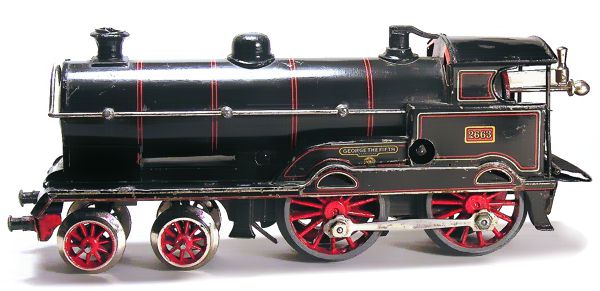Company Profile: Bing
History in a Nutshell
 Bing, or Gebrüder Bing ("Bing
Brothers"), was a German toy company founded in 1863 by Ignaz and Adolf Bing. Originally a manufacturer of metal kitchen utensils
and flatware, Bing (not to be confused with the search engine)
became best known for their tinplate toy trains, which they began making around 1880. By the early 20th Century, Bing's plant in
Nürnberg was the largest toy factory in the world.
Bing, or Gebrüder Bing ("Bing
Brothers"), was a German toy company founded in 1863 by Ignaz and Adolf Bing. Originally a manufacturer of metal kitchen utensils
and flatware, Bing (not to be confused with the search engine)
became best known for their tinplate toy trains, which they began making around 1880. By the early 20th Century, Bing's plant in
Nürnberg was the largest toy factory in the world.
Bing perfected the "Nürnberg Style" of toy manufacturing, which involved lithographing colorful designs on steel sheets that were stamped, formed, and assembled using tabs and slots. The method remained in widespread use well into the 1950s, long after Bing was gone. In addition to many different toys such as ships, planes, cars and even teddy bears, Bing made live steam stationary engines, scientific and educational novelties, and an enormous range of kitchenware, tableware, office equipment, record players, electrical goods and so on.

In the early days of toy trains, Bing and Märklin, their main competitor at the time, both introduced a number of similar gauges, which caused considerable confusion. For instance, Bing's IV gauge was the same as Märklin's III Gauge, even though Märklin had formalized standards for track gauges in 1891. Bing introduced OO Gauge (1:76.2) in the early 1920s, but while it became a British standard still in use today, HO Scale (1:87.1), which uses the same track gauge, was adopted everywhere else, and went on to become the most popular model railroading scale worldwide.

World War I and the death of Ignaz Bing in 1918 caused considerable setbacks for the company, and it struggled to survive. By the early 1920s they were once again enjoying strong sales in the United States thanks largely to Sears, Roebuck & Co; however, Lionel had also begun selling through Sears, which began to squeeze Bing out of the market. By 1927 Bing was in serious financial trouble, and Stephan Bing left the company to help establish Trix. The company was in liquidation by 1932 and was gone the following year; much of its tooling was acquired by rival toy company Bub.
